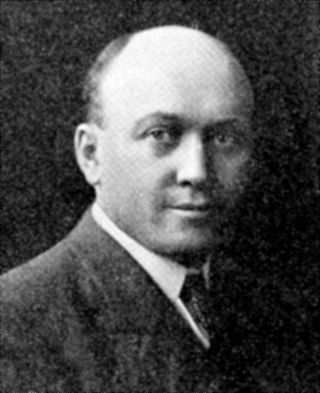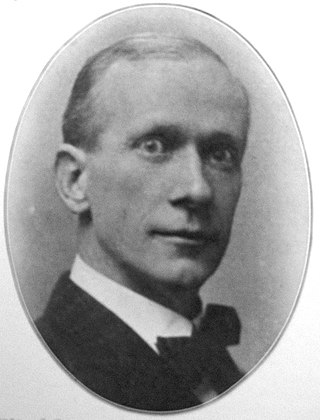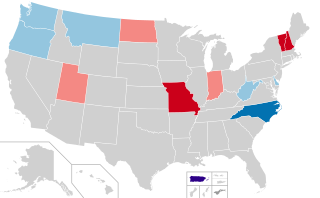
Hiram Warren Johnson was an American attorney and politician who served as the 23rd governor of California from 1911 to 1917 and represented California in the U.S. Senate for five terms from 1917 to 1945. Johnson achieved national prominence in the early 20th century as a leading progressive and ran for vice president on Theodore Roosevelt's Progressive ticket in the 1912 presidential election. As a U.S. senator, Johnson was a leading critic of the foreign policy of both Woodrow Wilson and Franklin D. Roosevelt.

The governor of Oregon is the head of government of Oregon and serves as the commander-in-chief of the state's military forces. The title of governor was also applied to the office of Oregon's chief executive during the provisional and U.S. territorial governments.

Oswald West was an American politician, a Democrat, who served most notably as the 14th Governor of Oregon.
The Progressive Party was a political party created as a vehicle for Robert M. La Follette, Sr. to run for president in the 1924 election. It did not run candidates for other offices, and it disappeared after the election. The party advocated progressive positions such as government ownership of railroads and electric utilities, cheap credit for farmers, the outlawing of child labor, stronger laws to help labor unions, more protection of civil liberties, an end to American imperialism in Latin America, and a referendum before any president could lead the nation into war.

Jay Bowerman was an American politician of the Republican Party who served as the 13th Governor of Oregon, for the final few months of the term of Frank Benson, who retired due to illness.

Frank Williamson Benson was an American politician, a Republican, and the 12th Governor of Oregon from 1909 to 1910. A native of California, Benson also served as educator, a land office clerk, and was twice elected as Oregon Secretary of State. From this position he became governor after sitting governor George Earle Chamberlain resigned to become a United States senator.

Ben Wilson Olcott was an American politician of the Republican Party who served as the 16th Governor of Oregon.

United States gubernatorial elections were held on November 5, 2002, in 36 states and two territories. The Republicans won eight seats previously held by the Democrats, as well as the seat previously held by Minnesota governor Jesse Ventura, who was elected on the Reform Party ticket but had since renounced his party affiliation. The Democrats won 10 seats previously held by the Republicans, as well as the seat previously held by Maine governor Angus King, an independent. The elections were held concurrently with the other United States elections of 2002.

The 1958 New York state election was held on November 4, 1958, to elect the governor, the lieutenant governor, the state comptroller, the attorney general, a judge of the New York Court of Appeals and a U.S. Senator, as well as all members of the New York State Assembly and the New York State Senate.

The 1938 New York state election was held on November 8, 1938, to elect the governor, the lieutenant governor, the state comptroller, the attorney general, two U.S. Senators and two U.S. Representatives-at-large, as well as all members of the New York State Assembly and the New York State Senate. The 1938 election was the first election where the Governor of New York was elected to a four-year term, rather than a two-year term as was used since the 1894 election.

The 1914 New York state election was held on November 3, 1914, to elect the governor, the lieutenant governor, the Secretary of State, the state comptroller, the attorney general, the state treasurer, the state engineer, a U.S. Senator and a judge of the New York Court of Appeals, as well as all members of the New York State Assembly and the New York State Senate, and delegates-at-large to the New York State Constitutional Convention of 1915.

The 1910 California gubernatorial election was held on November 8, 1910. It saw Republican Hiram Johnson elected as the state's governor. Johnson won the election with 45.9% of the popular vote, and became the 23rd governor of California. This was the first gubernatorial election in which Fresno County, Modoc County, San Benito County, Stanislaus County, and Tulare County voted for a Republican candidate. These Republican flips of traditionally Democratic counties foreshadowed the future Republican dominance of California gubernatorial elections that began in the next election.

The 1994 Minnesota gubernatorial election took place on November 8, 1994, in the midst of that year's Republican Revolution. Incumbent Republican Arne Carlson easily won re-election over Democrat–Farmer–Labor state senator John Marty.

The 1982 Alaska gubernatorial election took place on November 2, 1982, for the post of Governor of Alaska. To replace outgoing Republican governor Jay Hammond, Democratic nominee Bill Sheffield defeated three opponents: Republican nominee Tom Fink, Libertarian nominee Dick Randolph and Alaskan Independence Party nominee Joe Vogler. Hammond had endorsed his lieutenant governor, Terry Miller, who lost the Republican nomination to Fink in the primary election, as did Don Wright. Sheffield defeated Steve Cowper and former Lieutenant Governor H. A. Boucher for the Democratic nomination.

United States gubernatorial elections were held on November 8, 2016, in 12 states and two territories. The last regular gubernatorial elections for nine of the 12 states took place in 2012. The last gubernatorial elections for New Hampshire, Oregon, and Vermont took place in 2014, as Oregon held a special election due to the resignation of Governor John Kitzhaber, while the governors of New Hampshire and Vermont both serve two-year terms. The 2016 gubernatorial elections took place concurrently with several other federal, state, and local elections, including the presidential election, Senate, and House elections.

The 1960 Washington gubernatorial election took place on November 8, 1960, between incumbent Democratic governor Albert Rosellini and State Superintendent of Public Instruction Lloyd J. Andrews, nominated by the Republican Party.

The 1956 Washington gubernatorial election took place on November 6, 1956, between Democratic state senator Albert Rosellini and Republican lieutenant governor Emmett T. Anderson.

United States gubernatorial elections were held on November 8, 2022, in 36 states and three territories. As most governors serve four-year terms, the last regular gubernatorial elections for all but two of the seats took place in 2018. The gubernatorial elections took place concurrently with several other federal, state, and local elections, as part of the 2022 midterm elections.

The 1904 Wisconsin gubernatorial election was held on November 8, 1904.

Daniel James Malarkey, known as Dan Malarkey, was an attorney and politician from the state of Oregon. He served one two-year term in the Oregon House of Representatives followed by two non-consecutive four-year terms in the Oregon State Senate. Malarkey was a moderate Republican who represented Multnomah County in both chambers. He served as President of the Oregon Senate during the 1913 legislative session. Malarkey was known as a champion of progressive legislation including sponsoring Oregon’s first public utilities law and the state’s first minimum wage law that covered women. He was also one of the state’s most prominent attorneys for over 40 years. Malarkey actively opposed the influence of the Ku Klux Klan in Oregon. His legal efforts were successful in having a Klan-sponsored education bill declared unconstitutional, a decision that was ultimately upheld by the United States Supreme Court.





















